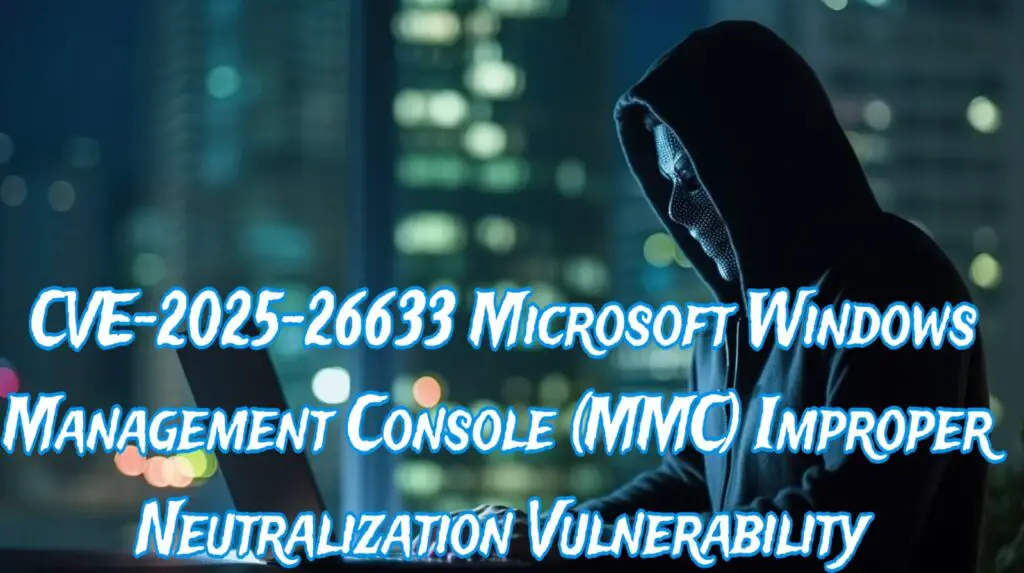CVE-2025-26633 Microsoft Windows Management Console (MMC) Improper Neutralization Vulnerability

Introduction
Microsoft recently disclosed a security feature bypass vulnerability in Microsoft Management Console (MMC), identified as CVE-2025-26633. This vulnerability, classified as Important, allows an attacker to bypass security restrictions under certain conditions. As cybersecurity threats continue to evolve, understanding the risks associated with such vulnerabilities is crucial for IT administrators, security professionals, and end-users.
In this blog, we will explore the details of this vulnerability, its impact, exploitability, mitigation measures, and best practices to ensure security.
Vulnerability Overview
CVE ID: CVE-2025-26633Impact: Security Feature BypassSeverity: ImportantWeakness: CWE-707: Improper NeutralizationCVSS Score: 7.0 (High Confidentiality, Integrity, and Availability Impact)Attack Vector: LocalAttack Complexity: HighPrivileges Required: NoneUser Interaction: RequiredExploit Code Maturity: FunctionalRemediation Level: Official FixReport Confidence: Confirmed
Technical Details
The vulnerability arises from improper neutralization of specific inputs within Microsoft Management Console (MMC). This improper neutralization can be leveraged by attackers to bypass security mechanisms, potentially leading to unauthorized actions on a target system. While the exploitability of this vulnerability is considered high due to the required user interaction and specific environmental conditions, it still poses a significant security risk.
How Does the Exploit Work?
To exploit this vulnerability, an attacker must trick a user into opening a specially crafted file. This can be achieved through various attack vectors, including:
- Email-based attacks: An attacker sends a malicious attachment disguised as a legitimate MMC file, convincing the user to open it.
- Web-based attacks: A malicious website hosts the exploit file, tricking users into downloading and executing it.
- Compromised software supply chain: Attackers may embed the exploit into third-party software that integrates with MMC, leading to security feature bypass.
Attack Complexity and User Interaction
The CVSS metric indicates that the attack complexity is High (AC:H), meaning the attacker needs to take additional steps before executing the exploit. The User Interaction Required (UI:R) metric further suggests that the attack relies on social engineering, where users must take specific actions for exploitation to occur.
Exploitability and Public Disclosure
- Has this vulnerability been publicly disclosed? No
- Has it been actively exploited? Yes, exploitation has been detected in the wild.
Since this vulnerability has been actively exploited, organizations should prioritize patching to prevent potential security breaches.
Affected Systems and KB Patches
The following Windows versions are affected by this vulnerability:
- Windows Server 2025 (KB5039374)
- Windows 11 Version 24H2, 23H2, 22H2 (KB5039381, KB5039382, KB5039383)
- Windows 10 Version 22H2, 21H2, 1607 (KB5039384, KB5039385, KB5039386)
- Windows Server 2016, 2012 R2, 2012, 2008 R2, 2008 (KB5039387, KB5039388, KB5039389, KB5039390, KB5039391)
- Windows 10 for ARM64 and x64-based Systems (KB5039392, KB5039393)
Microsoft has released patches as part of its March 11, 2025 security update. Users must ensure their systems are updated to the latest version.
Mitigation and Security Best Practices
1. Apply Security Updates
Microsoft has released an official fix for this vulnerability. Administrators should apply the latest updates as soon as possible to mitigate risks.
2. Enable Security Policies
System administrators can use Group Policy settings to restrict the execution of untrusted MMC files. Configuring policies to allow execution only from trusted sources can reduce the risk of exploitation.
3. Educate Users on Social Engineering
Since this exploit requires user interaction, organizations must educate employees about phishing attacks and malicious file attachments. Users should:
- Avoid opening email attachments from unknown sources.
- Be cautious when downloading files from the internet.
- Verify the legitimacy of links before clicking them.
4. Deploy Endpoint Protection Solutions
Security tools like Microsoft Defender and third-party Endpoint Detection and Response (EDR) solutions can detect and block suspicious MMC execution.
5. Monitor for Indicators of Compromise (IoCs)
Administrators should monitor logs for unusual MMC file executions and suspicious activities. Common IoCs include:
- Unexpected MMC executions in user directories.
- Abnormal access requests to system files.
- Presence of unusual MMC-related registry changes.
6. Implement Least Privilege Access
Minimizing user permissions can limit the potential impact of a successful exploit. Ensure users operate with standard privileges and restrict administrative access unless necessary.
Potential Impact if Left Unpatched
If left unpatched, CVE-2025-26633 can lead to:
- Unauthorized access to sensitive data: Attackers may bypass security restrictions and gain access to critical system information.
- Execution of malicious commands: Exploiting this vulnerability could allow attackers to execute harmful commands.
- Propagation of further attacks: Attackers could leverage this security flaw to establish persistence or move laterally within a network.
Case Study: Real-World Exploitation
A cybersecurity firm recently detected a targeted attack where hackers exploited this vulnerability using a weaponized MMC file delivered via phishing emails. The attack led to:
- Unauthorized data exfiltration from a financial institution.
- Privilege escalation through bypassed security mechanisms.
- Deployment of malware to further compromise the system.
This case study underscores the urgent need for patching and adopting security best practices.
Closing summary
CVE-2025-26633 is a significant security vulnerability that requires immediate attention. Organizations must prioritize patching, educating users, and enhancing endpoint security to mitigate the risk.
By following best security practices and staying vigilant, businesses can protect their systems from exploitation and ensure a secure computing environment.
For more details, visit the Microsoft Security Update Guide and apply the necessary patches today.
Related posts:
- HP Support Assistance Privilege Escalation CVE-2020-6917
- Updating Microsoft Store Apps with Offline Bundles
- Another Blue Screen of Death after installing July 2024 month Patch
- CrowdStrike update bricking Windows machines around the world
- CVE-2024-1212 Unauthenticated Command Injection in Progress Kemp LoadMaster
- [Solved] VMware vCenter Server Heap-Based Buffer Overflow Vulnerabilities (CVE-2024-38812 & CVE-2024-38813)
- [Solved] Microsoft Windows Explorer AutoPlay Not Disabled” Vulnerability
- CVE-2024-43491: Microsoft Windows Update Remote Code Execution Vulnerability
- Discover Hidden Browsing Threats: Free Risk Assessment for GenAI, Identity, Web, and SaaS Risks
- [Solved] Windows Cached Logon Credentials Vulnerability
